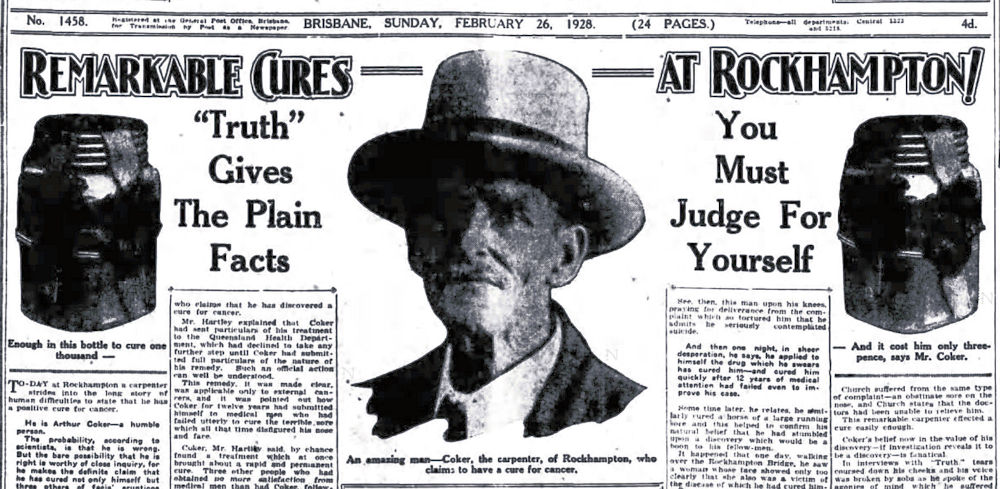By Coker descendant Warren Nunn
Arthur Coker was plagued by painful skin cancer. Despite medical attention, his condition worsened. It almost drove him to suicide.
In desperation he applied an arsenic-based potion to the “rodent ulcer” on his nose. Within days it started to heal and the discomfort he’d battled for years slowly went away.
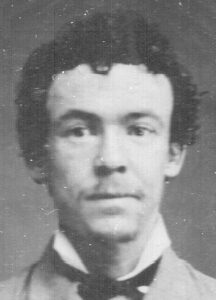
Arthur Coker as a young man.
Had Arthur Coker, a carpenter from Emu Park near Rockhampton in Queensland, stumbled upon a miracle cure?
Almost a century ago far less was known about skin cancer and treatments were emerging.
Arthur Coker’s “rodent ulcer” is now described as basal cell carcinoma. A remedy is now far more straightforward. However, without the appropriate treatment these tumours can extend or grow into surrounding structures and damage them.
It seems that this had happened to Arthur Coker. His self-treatment cleared the facial sores. However, it could not permanently cure his condition as he later discovered.
But, at the time, he believed he had a cure and shared the news with others.
On one occasion while walking across the Fitzroy River bridge in Rockhampton in 1926, he encountered a woman who had an obvious skin cancer.
He stopped and explained that he had a treatment that cleared up his cancer. Would she like to try his potion on her face?
Arthur Coker recounted the meeting in an interview published in the Truth newspaper of 26 February 1928.
Glowing testimonial
That woman on the bridge later gave a testimonial of the “Coker cancer cure”:
“My name is Mary Caroline Wassman, married woman, and I reside at 128 Gladstone-street, Rockhampton. I have suffered from cancer in the nose and face for over 10 years. I have consulted several doctors and have also been an outpatient of the Rockhampton General Hospital, but could not get any relief or cure and was gradually becoming worse. I placed myself in Mr Coker’s hands on August 27, 1926 and agreed to carry out his instruction and allowed him to treat me and use his cure on me. Since that date I have made rapid strides towards recovery, and at the present time my forehead and face are practically cured.”
Fair and accurate reporting
The Truth‘s treatment of Arthur Coker was refreshingly balanced. While not endorsing his claims with regards to his “cancer cure”, the newspaper presented a fair description of the situation while at the same time engaging with medical authorities for their responses.
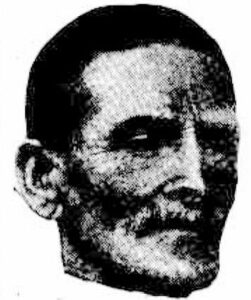
Arthur Coker photo published in Truth newspaper in 1928 shows that his facial cancer was “healed”.
The paper’s preface to the front-page article is a study in how journalism should be; present the facts as best can be ascertained and allow the reader to decide.
The preface reads:
It would be the cruellest of savageries to give false hope to the cancer sufferer. “Truth” would be unworthy of its trust as the people’s tribune if it did such a thing. However, this paper has investigated the claims of the Rockhampton carpenter — that he cured himself and others of this cursed disease. The simple facts are set out in the article on this page — set out much in the same way as a judge presents facts to a jury. If you are vitally interested — read and decide for yourself. A newspaper with a soul can do no more or less than this.
The opening paragraphs set the scene:
Today at Rockhampton a carpenter strides into the long story of human difficulties to state that he has a positive cure for cancer.
He is Arthur Coker — a humble person.
The probability, according to scientists, is that he is wrong.
But the bare possibility that he is right is worthy of close inquiry, for he makes the definite claim that he has cured not only himself but three others of facial eruptions diagnosed as rodent ulcers. And his claim is supported.
For more than a decade, Arthur Coker had gone from hospital to hospital for treatment, including to the Prince Alfred Hospital in Sydney.
The article continues:
He was given ointment and potions and a jungle of advice.
They used the X-ray on him and they submitted him to radium treatment.
He spent much money seeking relief from the dreadful affliction which, on his own confession, brought him almost to the point of self-destruction.
Push to investigate Coker’s claims
The work of Dr Ernest Sandford Jackson in addressing the cancer “scourge” was lauded and the question raised. Why not investigate Arthur Coker’s claims?
Coker’s biggest supporter was Robert Elliot Hartley who at the time was Rockhampton Harbour Board chairman. Hartley had been chairman of the North Rockhampton Borough Council at the same time that Arthur Coker was an alderman about 20 years earlier.
The paper quoted Mr Hartley who said that Coker had sent information about his treatment to the Queensland Health Department, which had declined to take any further step until Coker had submitted full particulars of the nature of his remedy.
The Truth wisely observed: “Such an official action can well be understood.”
A touching description
The Truth outlined Coker’s tough journey in this manner:
Coker tells a powerful story.
As a carpenter and a hard-working and ambitious man Coker’s employment took him to all parts of Queensland.
He put up many a house out West and it was among the cattle that first he fell upon the idea of his cure for ulcerating sores.
He saw how hardened and experienced stockmen treated beasts, but he never imagined that the time would come when he would adopt and improve such rough veterinary methods to the alleviation of his own agony.
As the years crowded upon him a sore developed on his nose and it worried him. It disfigured him and in his disfigurement he was brought almost to the terrible shore where the aches of his affliction, breaking one upon the other with cumulative monotony, threatened to wreck his mind.
He sought balm of many doctors — and the gall of disappointment continually was his lot.
He was in turn a patient at the Rockhampton hospital, and at the hospitals of Barcaldine, Clermont, Many Peaks, Emerald, and Brisbane. In Brisbane he consulted specialists without avail.
He went to Sydney to the Prince Alfred Hospital and submitted himself to radium treatment, again without avail.
For the comfort of his declining years he prudently had put aside sufficient money to carry him and his wife through, and with his own hands he built the home they now occupy at Emu Park, near Rockhampton.
See, then, this man upon his knees, praying for deliverance from the complaint which so tortured him that he admits he seriously contemplated suicide.
And then one night, in sheer desperation, he says, he applied to himself the drug which he swears has cured him — and cured him quickly after 12 years of medical attention had failed even to improve his case.
Some time later, he related, he similarly cured a horse of a large running sore and this helped to confirm his natural belief that he had stumbled upon a discovery which would be a boon to his fellow-men.
Loath to share too much information
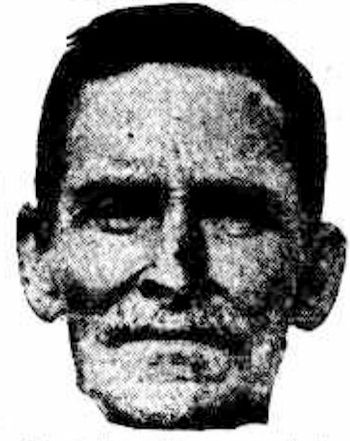
Another Arthur Coker image from Truth newspaper article.
At first, Arthur Coker did not trust what medical men (as he called them) would do if he divulged the contents of his treatment. He believed that they would exploit his “cure” and make money from it.
He insisted he did not want financial gain from his treatment.
The Truth pointed out that Coker was not after money. It said: “This man is no quack. He has not asked for payment. He does not ask for payment.”
Several months after the first article, the Truth again addressed the situation with a headline that read: “Coker’s cancer cure claim not yet investigated”
In it Arthur Coker revealed that he used arsenic in his potion but did not reveal what, if anything else, went into the salve he applied to facial cancers.
Dr Jackson, representing the Cancer Campaign Committee, said that arsenic was well known as a treatment for rodent ulcers, but it was not preferable to other known forms of treatment which were just as effective, less harmful, and generally adopted.
It seems that when Dr Jackson and others became aware that Arthur Coker was using arsenic, they were not prepared to revisit a possible solution that had already been tested.
But the Truth did not find the reaction helpful as the following excerpt shows:
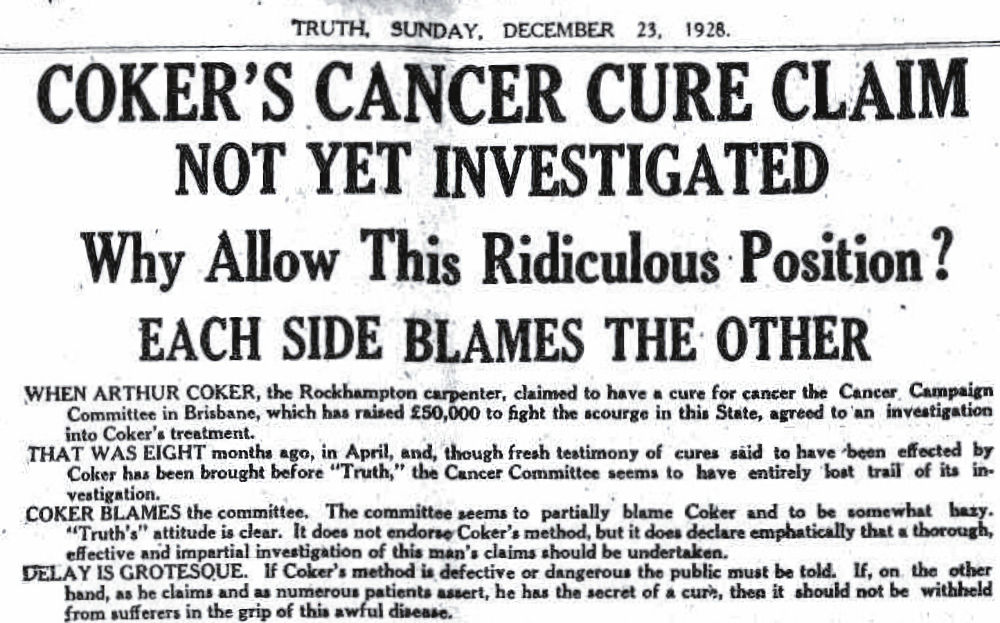
Excerpt from article in Truth newspaper on Sunday 23 December 1928, page 20.
What ‘cleared’ up Coker’s cancer?
Given that arsenic in a diluted form had some effect on healing external cancers, did Arthur Coker remain “cured” after he started using his potion?
His death certificate (below) shows that he was not cured, but that the insidious cancer was slowly developing and eating him away from the inside.
The causes of death are listed:
Ɪ (a) Metastases cervical glands left. (b) Carcinoma: basal-celled of face.
ꞮꞮ Cachexia
Ɪ (a) 30 odd years
According to one explanation, cervical lymph node metastases typically originate from primary carcinomas arising from mucosa of the head and neck, skin, salivary glands, or thyroid gland.
Cachexia is described as “a complicated metabolic syndrome related to underlying illness and characterised by muscle mass loss with or without fat mass loss that is often associated with anorexia, an inflammatory process, insulin resistance, and increased protein turnover”.
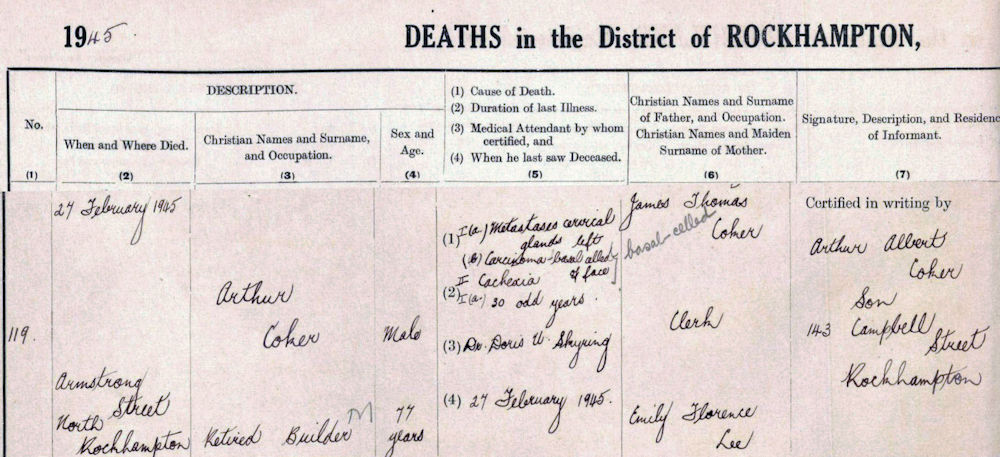
Excerpt from Arthur Coker’s death certificate. It shows he died from a basal cell carcinoma.
A tough, painful ending
According to one of his descendants, the cancer eventually ate away a portion of Arthur Coker’s face.
His potion could not cure the cancerous growth beneath the surface.
He died, aged 77, a victim of a cancer that is now far easier to diagnose and to treat.
The Coker family connection
I did not know Arthur Coker but he was my great-great grandfather Harry Coker’s older brother as shown in the outline below.
As it happens Arthur Coker and his brother Harry were baptised at the same time in July 1870. Three days later the Coker family sailed for Australia and settled in Rockhampton, Queensland.
About 100 years after the brothers were baptised, their respective great-grandsons (Ray Childs and Warren Nunn) were friends at Rockhampton High School.
As teenagers, we knew nothing of that relationship.
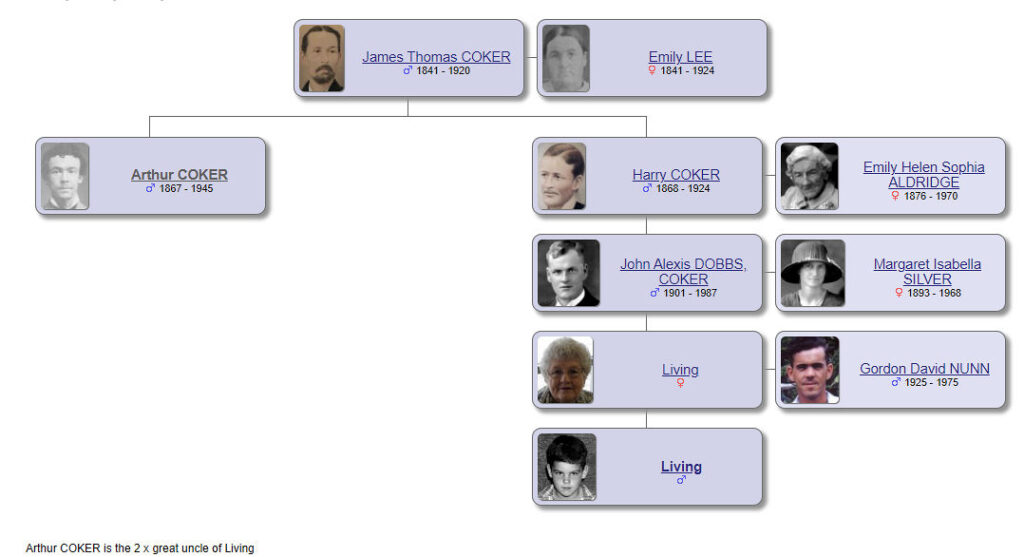
How the author Warren Nunn relates to Arthur Coker.

Brothers Arthur and Harry Coker were baptised the same day in London, England. Three days after this, the Coker family sailed to Australia and settled in Rockhampton, Queensland. Around 100 years later, Arthur’s great-grandson Ray Childs and Harry’s great-grandson Warren Nunn were school friends in Rockhampton.

